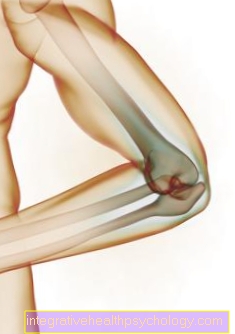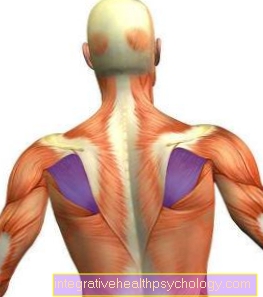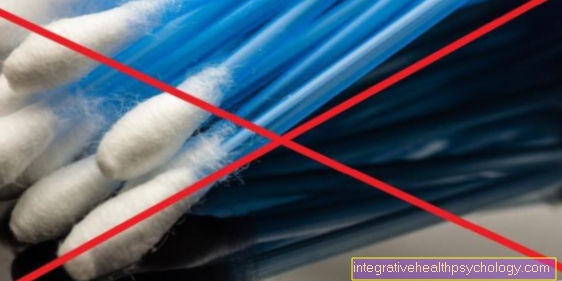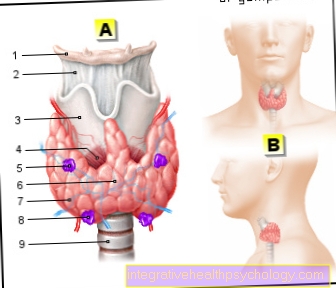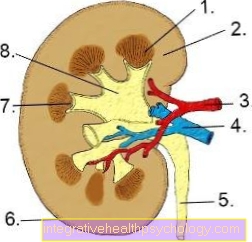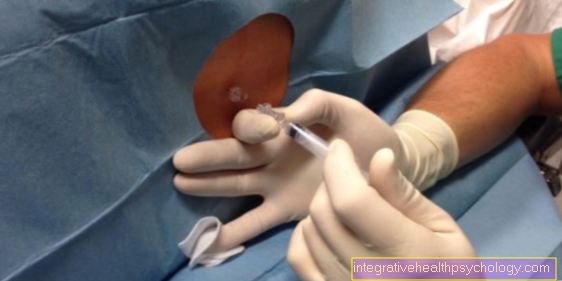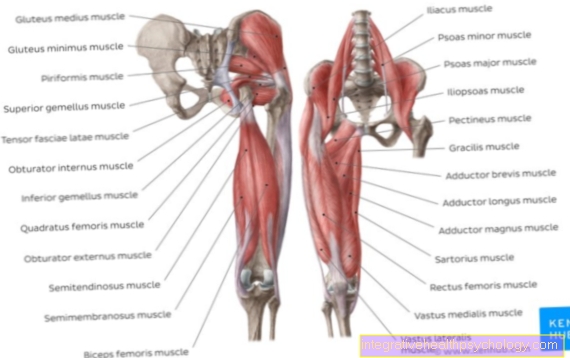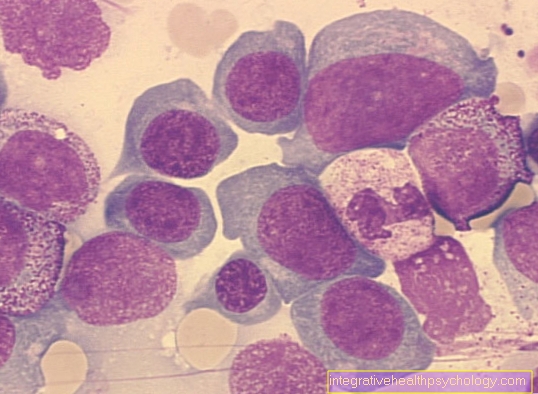Behcet's disease
introduction
In Behcet's disease, there is an inflammation of the small blood vessels, a so-called vasculit. The disease is named after the Turkish doctor Hulus Behcet, who first described the disease in 1937.
In addition to the vascular inflammation, the disease can also express itself in other organ systems. The cause has not yet been clearly clarified.

Symptoms of Behcet's disease
Behcet's disease is a systematic disease, which means that the disease can spread to the entire organ system. As a result, different symptoms can appear in different degrees in each patient. These include:
- Aphthae or ulceration in the mouth
- Apthae or ulceration on the anus
- Inflammation of the eye
- Skin changes and skin irritation
- Gastrointestinal complaints
- Joint inflammation
- Involvement of the nervous system
The main symptoms of Behcet's disease include painful canker sores in the mouth, which mostly occur in the back of the mouth, as well as canker sores or ulceration in the genital area and inflammation of the middle skin of the eye.
Other accompanying symptoms are various skin changes in some sufferers. It can be acne-like pustules, inflammation of the hair follicles, ulcers, lump formation or a tendency to skin irritation. Because Behcet's disease progresses in phases, there are always symptom-free intervals. Early signs or symptoms are mainly the recurring canker sores.
Apthene as the leading symptom
One of the main symptoms of Behcet's disease is canker sores. This is a painful damage to the skin or the mucous membrane. An inflamed border forms around the small ulcer. Their diameter is approximately 1 mm to 30 mm. They come on very quickly and can cause severe pain.
But they are not contagious.
In Behcet's disease, canker sores appear in the very early stages of the disease. They are often the first sign of systemic disease. The canker sores are usually found in the genital area or in the mouth.
The canker sores heal after a while, but return. Very large canker sores can leave scars. There is no drug treatment against the formation of canker sores, only various means can be used to relieve pain.
Read more on the topic: Aphthae-Different ways of treatment
Apthens in the genital area
One of the first symptoms of Behcet's disease is canker sores in the genital area.
A canker sore is painful damage to the mucous membrane or the skin in the genital area surrounded by an inflamed edge. So these are small ulcers. In boys, these mainly occur on the scrotum. These ulcers usually leave scars in adulthood.
In the female sex, the external genitals are usually affected. Here, too, there is usually scarred healing.
Involvement of the eye
Symptoms of the eye are common when you have Behcet's disease.
These symptoms are often the main problem with the disease. There may be a build-up of pus in the anterior chamber, a so-called hypopyon. In addition, there can be inflammation of the iris, known as uveitis. If this inflammation persists for a long time, it can lead to loss of eyesight. A dreaded complication is the blindness of those affected.
In order to rule out complications, a regular ophthalmological examination should be carried out on the affected person.
Involvement of the gastrointestinal tract
Behcet's disease can also cause symptoms in the intestine or digestive tract. Similar to the ulcers on the oral mucosa, there are defects in the lining of the intestine. Possible symptoms include feeling unwell, severe stomach cramps, black stools, or bloody diarrhea.
It is possible that the symptoms are similar to Crohn's disease (inflammatory bowel disease).
You might also be interested in this topic: Chronic Inflammatory Bowel Disease
Joint problems associated with Behcet's disease
Those affected by Behcet's disease can also experience problems in the joints. These are triggered by inflammation in the joint. This inflammation is usually very mild and usually heals after a few weeks without leaving any permanent damage.
The large body joints are mostly affected. The knee, ankle, wrist or elbow are very typical. The symptoms in the joints can manifest themselves as swelling, pain, stiffness and restricted mobility.
Further information on this: Rheumatoid arthritis
Therapy of Behcet's disease
The therapy of Behcet's disease consists mainly of the administration of cortisone. It is administered either in tablet form or intravenously, this depends, among other things, on the condition and severity of the symptoms of those affected.
The inflammation in the body is inhibited by the cortisone.
Local application of cortisone, e.g. in the form of an ointment, for externally visible inflammation, such as on the eye, is possible.
In the case of a very severe course of the disease or relapses, an immunosuppressive drug can also be prescribed or as an alternative. The immunosuppressant reduces the function of the immune system by restricting the growth of immune cells. A combination of the two drugs is often given when the central nervous system is involved.
Prognosis for Behcet's disease
Behcet's disease is a chronic disease. The disease often occurs in episodes, i.e. those affected have phases in which the symptoms are only slightly or barely noticeable and then also phases in which the symptoms typical for the disease are severe. In contrast to acute illnesses, there is no clearly definable end point. In the case of Behcet's disease, basically only the symptoms and not the causes can be treated.
The exact duration of the drug treatment cannot be determined across the board. However, it is years or the treatment can last the entire life of an affected person. The disease weakens the immune system, which can make the patient more susceptible to various other diseases.
If the disease was diagnosed in childhood, the symptom-free sections may become longer and longer. Resolution of Behcet's disease is also seen in some patients. However, it is not possible to make a general prognosis, the course of the disease is too individual for that.
It is also possible that complications may arise in the course of the disease, particularly the eyes. However, a reduced life expectancy due to the disease cannot be assumed.
Causes of Behcet's Disease
Unfortunately, the causes of Behcet's disease have not yet been finally clarified.
The cause is probably an autoimmune disease, which leads to inflammation of the blood vessels. For this reason, the disease is counted among the rheumatic types, since autoimmune reactions lead to inflammation, for example in the joints.
A genetic predisposition is also suspected in those affected, as the disease is more common in certain local areas. Due to the genetic predisposition, the immune system, which is supposed to protect the body from invading viruses and bacteria, is no longer properly functional. It recognizes the body's own tissue as an intruder and therefore attacks it. So it fights itself. This leads to the inflammatory reactions.
In Behcet's disease, these disturbed autoimmune reactions can be found in the small vessels. As a result, the inflammation occurs particularly in the skin, in the mucous membrane (mucus-forming tissue that lines the digestive, genital and urinary organs) and in the eye.
Scientists suspect that external influences such as bacterial and viral inflammation also play a role.
Also read our topics:
- Therapy of rheumatoid arthritis
- Raynaud's Syndrome
How is Behcet's disease diagnosed?
The diagnosis of patients with Behcet's disease is usually made after externally visible symptoms appear. These include in particular the canker sores in the mouth as well as the sores in the genital area and other typical skin changes.
In addition, a test can clarify whether you have Behcet's disease or not. This test is called the pathergy test. Saline solution is injected directly under the skin. If a skin reaction with lump formation and inflammation occurs at this point a short time later, the patient is most likely suffering from Behcet's disease.
In addition, immunological blood tests or an MRI can be done to establish the diagnosis.
HLA B51 in blood tests for Behcet's disease
The HLA system is a group of proteins that occur on the surface of cells and are important for the function of the immune system. The abbreviation HLA comes from the English (Human Leukocyte Antigen).
HLA typing can be performed in patients with Behcet's disease. It is determined whether the patient is HLA B51 positive. This is the case in 70 percent of all Behcet's disease.
As part of the diagnosis of Behcet's disease, HLA is also determined. For more information, read the following article: HLA - Human Leukocyte Antigen
Is Behcet's Disease Contagious?
According to current knowledge, Behcet's disease is not contagious. This is because an autoimmune disease, i.e. a genetic defect, is described as the probable cause. The immune system, which is actually there to fight viruses, bacteria or fungi, recognizes the body's own tissue as "foreign" and begins to fight it. This incorrect programming of the immune system is anchored in the genes and is therefore not contagious.
The symptoms of this disease are also not contagious. This also includes canker sores in the genital area or in the mouth.
Contrary to popular belief, there is no risk of infection even with canker sores.


.jpg)

